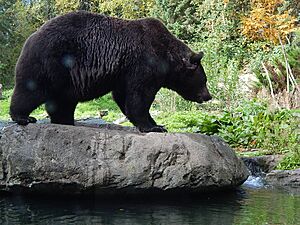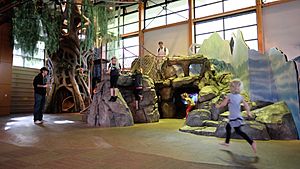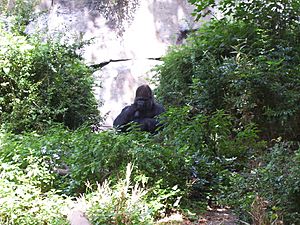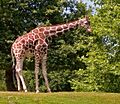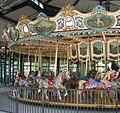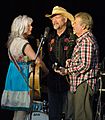Woodland Park Zoo facts for kids
 |
|
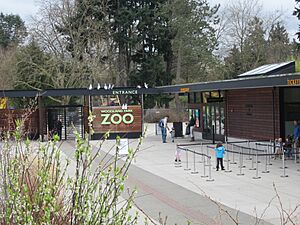
Main entrance
|
|
| Date opened | 1899 |
|---|---|
| Location | Woodland Park, Seattle, Washington, U.S. |
| Land area | 92 acres (37 ha) |
| Coordinates | 47°40′06″N 122°20′59″W / 47.66834°N 122.34984°W |
| No. of animals | 900 |
| No. of species | 250 |
| Annual visitors | 1+ million |
| Memberships | AZA |
| Major exhibits | Trail of Vines, Northern Trail, Tropical Rain Forest, Banyan Wilds, African Savanna, Australasia |
The Woodland Park Zoo is a special place in Seattle, Washington, USA. It's a zoological garden that helps protect wild animals. The zoo is located in the Phinney Ridge neighborhood. It has won over 65 awards for its work. About 900 animals from 250 different species live here. More than 1 million people visit the zoo every year.
Contents
History of the Zoo
The Woodland Park Zoo started as a small collection of animals. This was on the large property of Guy C. Phinney. He was a lumber mill owner and real estate developer. In 1899, after Phinney passed away, his wife sold the land to the city of Seattle. This land became Woodland Park.
In 1902, a famous design firm called Olmsted Brothers helped plan the city's parks. They also helped design Woodland Park. The next year, animals from another private collection were moved to the new park. This was the beginning of the Woodland Park Zoo.
In 1975, the zoo's director, David Hancocks, had a new idea. He wanted to design animal exhibits that looked like their natural homes. This idea was called "landscape immersion." The first exhibit designed this way was for gorillas. It used natural plants and rocks. It also made the environment quiet and peaceful. At first, some people worried about this new idea. But it became a very popular way to design zoo exhibits. Many zoos around the world now use this method.
What You Can See at the Zoo
The Woodland Park Zoo covers 92 acres. This includes exhibits, public areas, and playgrounds. The zoo is open every day. In 2006, over 1 million people visited.
The zoo is home to:
- 1,090 individual animals
- 300 different animal species
- 35 endangered species and 5 threatened species
- 7,000 trees
- Over 50,000 shrubs and herbs
- More than 1,000 plant species
- A special sensory garden
Exciting Animal Exhibits
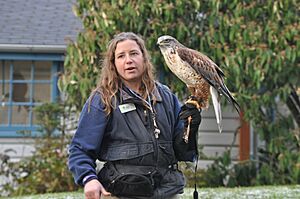
The Woodland Park Zoo has won many awards for its exhibits. These awards come from the Association of Zoos and Aquariums. The zoo is famous for creating the world's first "immersion exhibit." This was the gorilla habitat, which opened in the late 1970s.
Here are some of the zoo's amazing exhibits:
- Tropical Asia: This is the zoo's biggest section. It focuses on animals from South and Southeast Asia.
- Assam Rhino Reserve: This area has a large exhibit for the zoo's Indian rhinoceros.
- Banyan Wilds: Here you can see Malayan tigers, sloth bears, and Asian small-clawed otters. There is also a small bird area.
- The Trail of Vines: This section houses orangutans, siamangs, pythons, and Malayan tapir. The Rhino Reserve used to be the Elephant Forest. It was changed for rhinoceroses in 2018.
- African Savanna: This section has animals from the grasslands of Africa.
- The largest area is for herbivores like giraffes, zebras, and ostrich.
- You can also find African lions, warthogs, and Patas monkeys. There's a small bird area too.
- This area also looks like an East African village. It won an award in 1981.
- Australasia: This area is home to Australian animals.
- An outdoor exhibit is shared by emus, common wallaroos, and red-necked wallabys.
- Willawong Station: Here, you can feed Australian parrots with a seed stick.
- There is also a snow leopard nearby.
- Living Northwest Trail: This habitat shows animals from the taiga (northern forests) of Northwestern America.
- Exhibits include grizzly bears, mountain goats, elk, river otters, Steller's Sea Eagles, and wolfes.
- This area is designed to look like a real trail in Alaska's Denali National Park. It won an award in 1995.
- Tropical Rainforest: This exhibit explores animals from the jungles of South America and Africa.
- The South American part has a jaguar exhibit.
- The African part has western lowland gorillas, ring-tailed lemurs, red ruffed lemurs, and colobus monkeys. This exhibit won an award in 1993.
- Temperate Forest: This area shows creatures from temperate woodlands around the world.
- Exhibits include southern pudus, red pandas, Chilean flamingos, Red-crowned cranes, White-naped cranes, and Maned wolves.
- There is a wetlands area and a special bird area for rare birds.
- Bug House: This is home to the zoo's Partula Snails.
- Farm Exhibit: Here, guests can pet farm animals like Kunekune pigs, Sheep, Goats, and Miniature Jersey Steer.
- Penguin Enclosure: This is home to many Humboldt penguins. It was updated in 2009. Now, visitors can watch the penguins swim underwater. The new habitat also uses green energy. It won a top award in 2010.
- Butterfly Garden: A beautiful garden filled with butterflies.
- Raptor Center: Home to different birds of prey.
- Trail of Adaptations: This building houses animals like the Komodo dragon and meerkat.
- Some animals, like tree kangaroos and Indian Peafowl, roam freely around the zoo grounds.
- Zoomazium: This is an indoor play area for young children. It encourages them to explore, exercise, and learn.
- Carousel: The zoo has an old-fashioned carousel that runs on solar energy. It was built in 1918 and later moved to the Woodland Park Zoo.
Zoo Community Involvement
The Woodland Park Zoo is very involved in protecting the environment. It works to save animals and their habitats. The zoo has its own educational programs for school children. It also works with universities, like the University of Washington. In 2010, the zoo closed its Night Exhibit. This was due to economic reasons.
Fun Fundraisers
ZooTunes is a summer concert series held at the zoo since 1983. These concerts help raise money for the zoo's programs. The zoo's North Meadow becomes an outdoor concert area. It can hold 3,700 people.
Famous Animals at the Zoo
From 1953 to 1968, a famous gorilla named Bobo lived at the Woodland Park Zoo. He was a western lowland gorilla. Bobo was bought as a baby from a hunter. He was raised by a family in Anacortes, Washington. Bobo brought many visitors to the zoo. He was one of Seattle's main attractions for many years. His popularity helped the zoo get money to build a new primate house.
A writer named Dawn Prince-Hughes spent many years at the zoo. She observed the western lowland gorillas. She wrote a book about her experiences.
In 2016, two lionesses from the zoo, Busela and Nobuhle, moved to another zoo. They went to breed with two male lions. Nobuhle gave birth to three cubs: Brutus, Titus, and Calliope.
In December 2015, a baby gorilla named Yola was born at the zoo. Her mother, Nadiri, was also born there.
On June 20, 2017, a baby giraffe named Lulu was born. She was 5 feet 7 inches tall and weighed 149 pounds. Her parents were Tufani and Dave. Her naming rights were sold at a zoo fundraiser. A male snow leopard cub was also born that summer. He was named Aibeck, which means "long life."
In 2022, two brown bear cubs, Juniper and Fern, came to the zoo. They were both female and had been orphaned. Juniper came from Alaska and Fern from Montana.
The last two Asian elephants at the zoo, Bamboo and Chai, moved to the Oklahoma City Zoo in 2015. Both have since passed away. In September 2024, Guadalupe, the last Hippopotamus at the zoo, moved to the San Diego Zoo.
Conservation Efforts
The Woodland Park Zoo works with other organizations to protect animals. They partner with the Oregon Zoo and government groups. They also work with conservation groups. These efforts help save threatened and endangered species. Examples include the Oregon silverspot butterfly and the western pond turtle.
Images for kids
-
A Keel-billed toucan at the Tropical Rain Forest exhibit.


